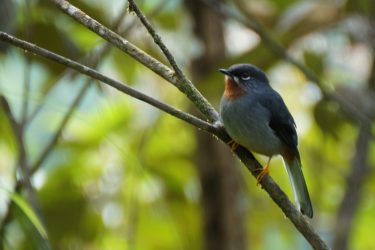In this series of blogs, Ed Drewitt freelance naturalist, broadcaster and wildlife detective highlights a different St Lucia bird each week. In this edition the St Lucia Warbler
By: Ed Drewitt
I usually encounter St Lucia warblers when I least expect to. Unlike bananaquits and Lesser Antillean bullfinches, they are less predictable birds and just seem to appear when I go for a walk or come out of my hotel room.

The St Lucia warbler is a tiny bird, bright yellow and similar in size and colour to the even more common bananaquit. I usually spot them feeding in trees and low vegetation, usually alone or in pairs or family groups across the island. It is an endemic bird, only found on St Lucia and feeds almost exclusively on small insects, searching amongst the leaves, branches and leaflitter, and occasionally flying out to snap up something in flight.

Its song, which can be heard here, is a rolling repeating sequence of notes, not unlike the Pacific wren or the Eurasian wren, of which it is unrelated. Hearing the song or call is a great way of locating a St Lucia warbler and it reminds me of teaching people birdsong back in the UK.

While the bananaquit can be found feeding on the nectar of flowers and insects, as well as sugar sachets in hotels, the St Lucia warbler is more at home of the fringes of hotels and homes and can be found in a whole variety of woodland and forest habitats. They can be quite tame at times so don’t be surprised if one moves amongst the trees just metres away from you. Up close you’ll see it has a short, thin straight beak, unlike the downcurved beak of a bananaquit. They feed on a variety of insects including caterpillars, ants and weevils, as well as other invertebrates such as spiders and small fruits.

They nest between March and June and you may spot them carrying nest material such as fine grasses or feathers. When the young hatch the adults will be collecting small insects. Males will be singing more during this time, ensuring other rival males know that this is his patch and to keep out. It is an important way to protect his nest and mate too.
In some books or webpages you may see it referred to as a subspecies of the Adelaide’s warbler. However, it does now have full species status as the St Lucia warbler.
Ed Drewitt is a freelance naturalist, broadcaster and wildlife detective
Learn More About Bird Watching at Anse Chastanet here


